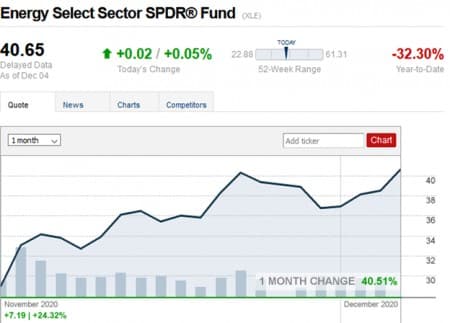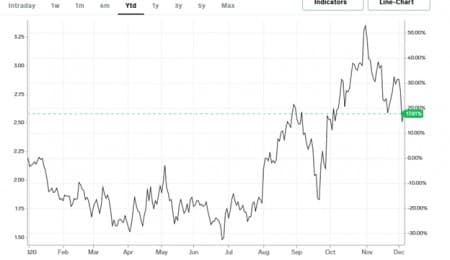Searching for potentially rewarding oil and gas stocks during the ongoing energy crisis can very much feel like dumpster diving.
The energy sector has been deeply out of favor over the past few years, with the Covid-19 pandemic only serving to make an already bad situation much worse.
With the sector's favorite benchmark S&P 500 Energy Sector SPDR (XLE) down 32% in the year-to-date, playing the long-game by buying beaten-down companies with good potential for a rebound might be the best strategy at this point.
Historically, a company's market cap tends to have an inverse or opposite relationship to both risk and return. On average, large-cap oil and gas with market capitalizations of US$10 billion and greater tend to grow more slowly and have less potential for returns. However, they are more stable than their smaller brethren. On the other hand, mid-cap companies (market cap between $2 and $10 billion) and small-cap companies (market cap between $300 million and $2 billion) tend to grow faster and have the potential for higher returns, but are more volatile and present a higher risk profile.
However, this crisis has not spared even behemoths with deep pockets, with the XLE's Top 10 stocks all deep in the red in the YTD.
Bigger oil and gas companies have, however, still held up better than their smaller peers, with heavily indebted shale and oilfield services companies generally faring the worst. According to the Haynes and Boone Oil Patch Bankruptcy Monitor, 32 U.S. energy companies have filed for bankruptcy protection in the YTD, reflecting aggregate debt of more than $49 billion.
The vast majority of those filings have been by companies operating in the Texas Shale Patch.
That said, the U.S. oil and gas sector has managed to stage a remarkable recovery over the past few months thanks to several potential Covid-19 vaccines coming close to mainstream distribution.
Indeed, several lesser-known energy stocks have been outperforming the U.S. oil and gas sector by a country mile. Related: Finding A Way Around The World's Largest Oil Chokepoint

Source: CNN Money
#1. Small-Cap: Renewable Energy Group
Market Cap: $2.3B
YTD Return: 120.2%
Iowa-based Renewable Energy Group (NASDAQ:REGI) is a biodiesel production company operating 13 biorefineries and a feedstock processing facility. The company manufactures biodiesel and renewable diesel from biomass feedstocks such as animal fats, distilled corn oil, and even used cooking oils.
REGI stock has been enjoying a remarkable run, up 100% over the past six months and a staggering 215% over the past 12 months, thanks to continuing solid performance even during the pandemic.
At a time when demand for transportation fuels has been drastically reduced by the coronavirus pandemic, diesel fuel demand has generally held up better compared to the demand for gasoline and jet fuels. Renewable Energy Group has also been benefiting big time from California's newly reinstated Low-Carbon Fuel Standard (LCFS) credits when it sells biomass-based diesel in the Golden State, even if the fuel is manufactured in Iowa.
During its latest earnings call, REGI reported that it sold 176M gallons of biodiesel and renewable diesel during the quarter, with revenue of $576.05M (-1.4% Y/Y)clocking iN $21.5M higher than the Wall Street consensus.
The increasing clamor to stamp a price on carbon in a bid to lower greenhouse gas emissions (GHGs) is likely to lift REGI higher. China, Japan, and South Korea have in recent weeks joined the European Union in pledging to lower GHG emissions to "net-zero" levels. U.S. President-elect Joe Biden has made a similar pledge in his election campaign with a $2T plan to cut emissions. Related: Oil Market Hopeful As Vaccinations Begin
According to the World Bank, 46 countries and 28 subnational regions are charging a carbon tax. The European Union's benchmark carbon permit price is currently at a 14-year high at just ~30 euros ($36) per tonne early on Monday, with the UN estimating that the social cost of carbon should be $40 - $80 metric ton.
How effective is the carbon tax? Well, emissions from participating power plants and factories have dropped by 35% since the EU system was launched 15 years ago.
#2. EQT Corporation
Market Cap: $4.24 billion
YTD Return: 31%
Natural Gas Prices (USD/MMBtu)

Source: Business Insider
Whereas the oil sector has just begun to show signs of a solid recovery, the natural gas camp has been doing much better. Gas prices have climbed nearly 18% in the year-to-date, but a lower-than-expected decrease in natural gas supplies and fears of a warm winter have recently been eroding those gains.
Still, natural gas stocks have been outperforming their oil or integrated energy peers. Pennsylvania-based EQT Corp.(NYSE:EQT) is up 60% over the past 12 months and remains one of the few fossil fuel stocks that are in the green this year. EQT is a pure-play natural gas company with ~17.5 trillion cubic feet of natural gas reserves.
EQT is no longer in growth mode and considers acquisitions as its second act in a bid to gain economies of scale and help it return capital to shareholders. EQT CEO Toby Rice sees "industrial logic" in a potential merger with CNX Resources (NYSE:CNX).
EQT also is considering a path to net-zero status, starting by replacing equipment that runs on fossil fuels with electric-powered devices as well as using real-time sensors and other technologies in a bid to cut drilling time and energy. ESG plays within the fossil fuel sector tend to go down well with investors.
#3. Mid-Cap: Apache Corp
YTD Return: -40.7%
Houston-based Apache Corp. (NYSE:APA) is one of the biggest players in the Permian Basin.
Apache recently made a world-class discovery at the Kwaskwasi-1 well located in the prolific Guyana-Suriname Basin, where it encountered 278 meters (912 feet) of net oil and volatile oil/gas-condensate pay.
"We are thrilled with the results from the Kwaskwasi-1 exploration well. This is the best well we've drilled in the basin to date, with the highest net pay in the best quality reservoirs," Apache CEO and President, John J. Christmann, gushed. "While we have a lot more work to do, a discovery of this quality and magnitude merits a pace of evaluation that enables the option of accelerated first production."
Last year, Bank of America Merrill Lynch touted the Suriname prospect as a potential game-changer for Apache:
"Suriname has the potential to reset the investment case," Merrill Lynch's veteran oil-industry analyst Doug Leggate said.
Apache was among the first shale companies to undertake deep spending cuts after oil prices crashed in March. Apache lowered its 2020 capex to $1B-$1.2B from its previous guidance of $1.6B-$1.9B. But it did not stop there: The company also cut the dividend by 90% to $0.025/share from $0.25. Apache has revealed that its 2020 capex is tracking towards the lower end of its guidance.
Its capital-light structure appears to be paying off.
During the company's latest earnings call, Apache's management said that the company would be running cash flow positive as long as WTI prices remain above $30/barrel (current WTI is $40.14). Further, the company said it would use any excess cash to pay down its debt.
However, should prices hit $50 or more, Apache said it would undertake very measured capex increases with the first column of that incremental free cash flow returned to investors, maybe through a dividend increase or share buybacks.
Overall, it appears investors are happy with Apache and have bid up the shares nearly 70% over the past 30 days.
By Alex Kimani for Oilprice.com
More Top Reads From Oilprice.com:
- Why Is Denmark Ditching Natural Gas?
- Oil Market Hopeful As Vaccinations Begin
- Finding A Way Around The World's Largest Oil Chokepoint



















Long $gis General Mills
Strong buy